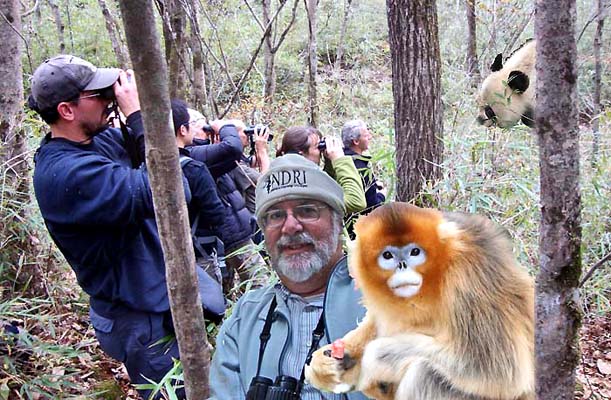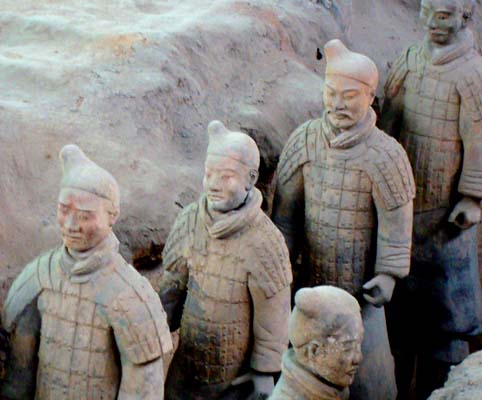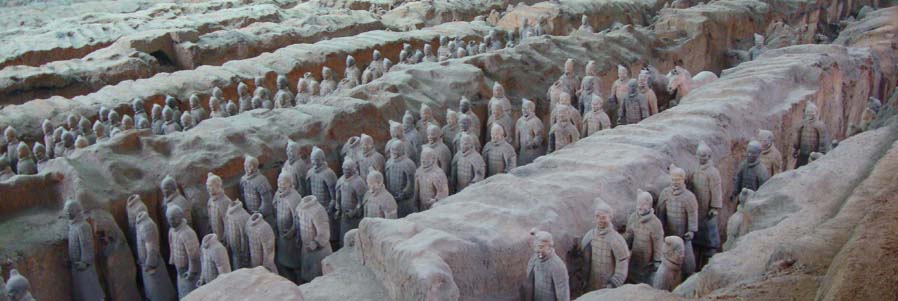
 This was a trip to central China with Indri Tours
in search of Giant Panda. There was an international group of 8
observers (from 6 countries) and our Indri guide, Simon Bellingham.
This was a trip to central China with Indri Tours
in search of Giant Panda. There was an international group of 8
observers (from 6 countries) and our Indri guide, Simon Bellingham.
Frankly, it was a very successful trip for everyone but me. I missed seeing a panda through bad luck and a lack of sufficient physical fitness.
In short, the monkey and I were not looking the right way when everyone else was ticking the panda (right). I will have that monkey on my back for a very long time . . . .

 But
let us not dwell on the negative. Herewith is a selection of the birds
and mammals which were encountered, many of them Chinese endemics,
including Spectacled Parrotbill (above) and Sooty Tit (right; it is a very tiny bird so it is flying out of your screen at more than double life size).
But
let us not dwell on the negative. Herewith is a selection of the birds
and mammals which were encountered, many of them Chinese endemics,
including Spectacled Parrotbill (above) and Sooty Tit (right; it is a very tiny bird so it is flying out of your screen at more than double life size).
We visited primarily two locations in Shaanxi Province, both in the Qinling Mountains southwest of Xi'an: Huayang Village and adjacent Changqing Reserve, and Foping Nature Reserve. Foping was our panda reserve. A primary reason to go to Changqing Reserve is that one has access to higher elevations there by road, along which one hopes for Takin, a huge goat antelope recalling Musk Ox. The Takin here in central China have a rich golden pelage and are known as 'Golden Takin,' Budorcas taxicolor bedfordi. We encountered two Takin in Changqing; one was particularly golden in the first rays of the sun (below).

 The
tour began and ended at Xi'an, a city of over 8 million, and only 30
miles from the world renowned Terra Cotta Warriors (left & below).
An army of these 5 foot tall figurines was buried in 210 B.C. with the
First Emperor of China, Qin Shi Huang. They were intended to allow him
to rule in the afterlife.
The
tour began and ended at Xi'an, a city of over 8 million, and only 30
miles from the world renowned Terra Cotta Warriors (left & below).
An army of these 5 foot tall figurines was buried in 210 B.C. with the
First Emperor of China, Qin Shi Huang. They were intended to allow him
to rule in the afterlife.
The burial site was destroyed in later wars, and the Terra Cotta Warriors were not discovered until 1974, when a local villager was digging a well. Current estimates are that in the three pits containing the Terra Cotta Army there were over 8,000 soldiers, 130 chariots with 520 horses and 150 cavalry horses, the majority of which are still buried in the pits. Most are smashed into many pieces, but hundreds have now been painstakingly reconstructed. Hints of the original paint are still visible, but all the weapons and horse-carts have disintegrated. Nonetheless it is a very impressive sight to see hundreds of warriors lined up to guard the Emperor. It is now considered one of the major 'wonders' of the ancient world.

Continue to pages on . . . |
|
Return to Introduction page |
|
page created 20 Nov 2010
|
© Don Roberson 2010 |